Zara Case Study: Multi-Brand Strategy and Global Retail
VerifiedAdded on 2019/12/04
|12
|3967
|1421
Case Study
AI Summary
This case study analyzes Zara, a Spanish clothing and accessories retailer, focusing on its internationalization strategy, competitive advantages, and multi-brand approach. It examines Zara's application of the Uppsala model, its competitive positioning against H&M and Gap Inc., and the advantages and disadvantages of its multi-brand strategy. The study also assesses Zara's ability to mitigate the risk of cannibalization and the implications of its joint venture with Tata in India. The analysis highlights Zara's success in the global fashion retail market, its emphasis on fast fashion, and its unique approach to store promotion and marketing. The case study offers insights into Zara's strategic decisions and their impact on its global presence and market share.

ZARA CASE STUDY
Paraphrase This Document
Need a fresh take? Get an instant paraphrase of this document with our AI Paraphraser
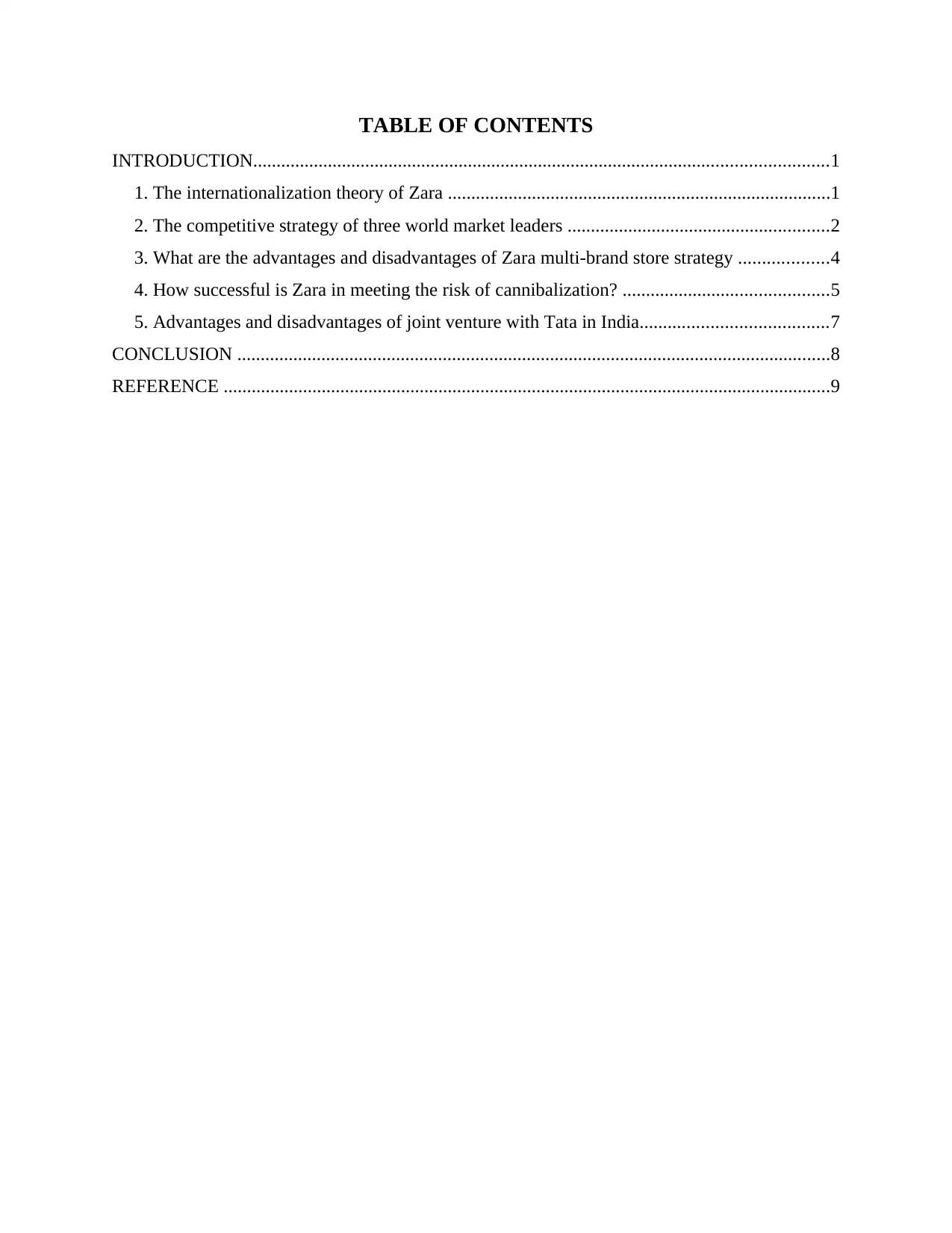
TABLE OF CONTENTS
INTRODUCTION...........................................................................................................................1
1. The internationalization theory of Zara ..................................................................................1
2. The competitive strategy of three world market leaders ........................................................2
3. What are the advantages and disadvantages of Zara multi-brand store strategy ...................4
4. How successful is Zara in meeting the risk of cannibalization? ............................................5
5. Advantages and disadvantages of joint venture with Tata in India........................................7
CONCLUSION ...............................................................................................................................8
REFERENCE ..................................................................................................................................9
INTRODUCTION...........................................................................................................................1
1. The internationalization theory of Zara ..................................................................................1
2. The competitive strategy of three world market leaders ........................................................2
3. What are the advantages and disadvantages of Zara multi-brand store strategy ...................4
4. How successful is Zara in meeting the risk of cannibalization? ............................................5
5. Advantages and disadvantages of joint venture with Tata in India........................................7
CONCLUSION ...............................................................................................................................8
REFERENCE ..................................................................................................................................9
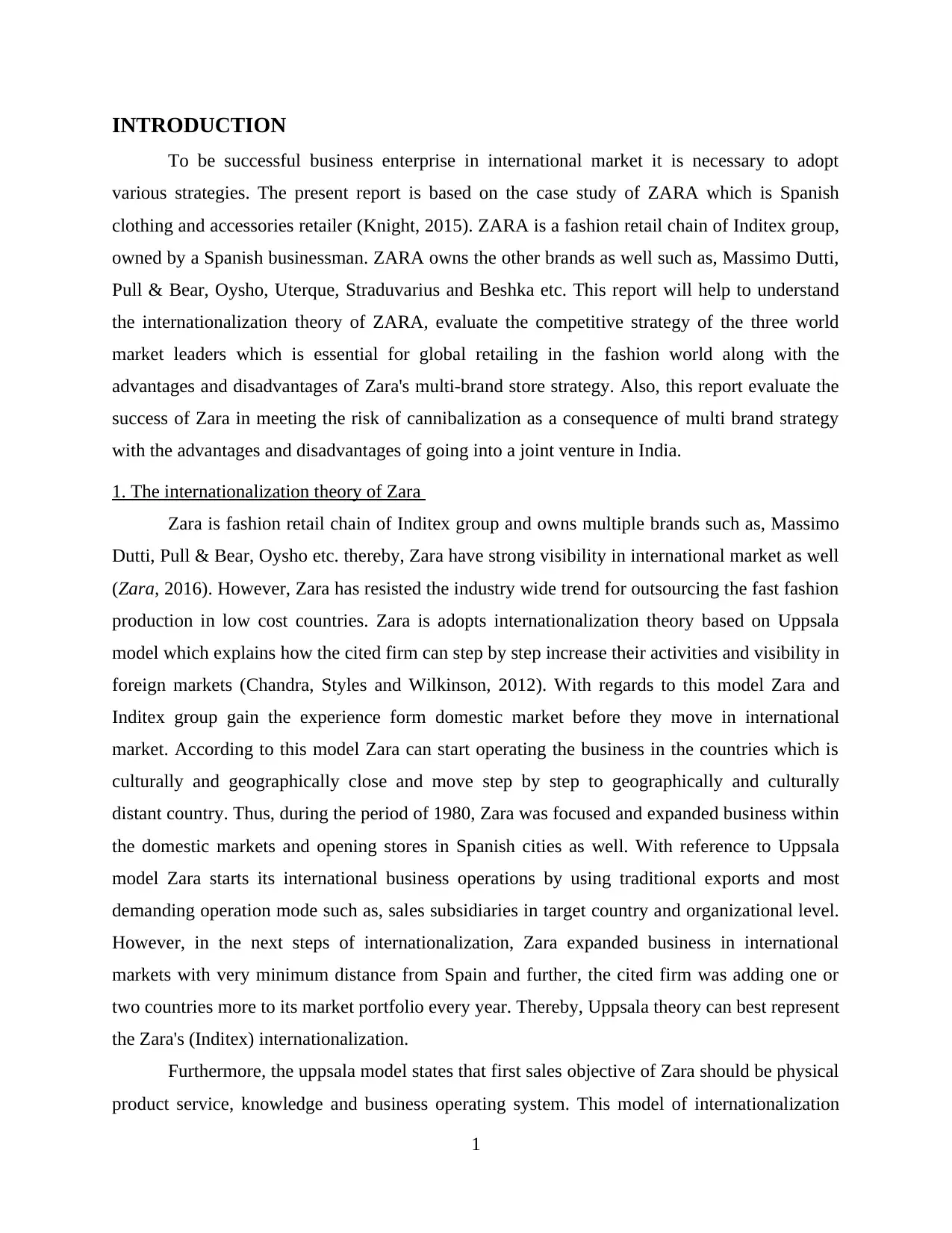
INTRODUCTION
To be successful business enterprise in international market it is necessary to adopt
various strategies. The present report is based on the case study of ZARA which is Spanish
clothing and accessories retailer (Knight, 2015). ZARA is a fashion retail chain of Inditex group,
owned by a Spanish businessman. ZARA owns the other brands as well such as, Massimo Dutti,
Pull & Bear, Oysho, Uterque, Straduvarius and Beshka etc. This report will help to understand
the internationalization theory of ZARA, evaluate the competitive strategy of the three world
market leaders which is essential for global retailing in the fashion world along with the
advantages and disadvantages of Zara's multi-brand store strategy. Also, this report evaluate the
success of Zara in meeting the risk of cannibalization as a consequence of multi brand strategy
with the advantages and disadvantages of going into a joint venture in India.
1. The internationalization theory of Zara
Zara is fashion retail chain of Inditex group and owns multiple brands such as, Massimo
Dutti, Pull & Bear, Oysho etc. thereby, Zara have strong visibility in international market as well
(Zara, 2016). However, Zara has resisted the industry wide trend for outsourcing the fast fashion
production in low cost countries. Zara is adopts internationalization theory based on Uppsala
model which explains how the cited firm can step by step increase their activities and visibility in
foreign markets (Chandra, Styles and Wilkinson, 2012). With regards to this model Zara and
Inditex group gain the experience form domestic market before they move in international
market. According to this model Zara can start operating the business in the countries which is
culturally and geographically close and move step by step to geographically and culturally
distant country. Thus, during the period of 1980, Zara was focused and expanded business within
the domestic markets and opening stores in Spanish cities as well. With reference to Uppsala
model Zara starts its international business operations by using traditional exports and most
demanding operation mode such as, sales subsidiaries in target country and organizational level.
However, in the next steps of internationalization, Zara expanded business in international
markets with very minimum distance from Spain and further, the cited firm was adding one or
two countries more to its market portfolio every year. Thereby, Uppsala theory can best represent
the Zara's (Inditex) internationalization.
Furthermore, the uppsala model states that first sales objective of Zara should be physical
product service, knowledge and business operating system. This model of internationalization
1
To be successful business enterprise in international market it is necessary to adopt
various strategies. The present report is based on the case study of ZARA which is Spanish
clothing and accessories retailer (Knight, 2015). ZARA is a fashion retail chain of Inditex group,
owned by a Spanish businessman. ZARA owns the other brands as well such as, Massimo Dutti,
Pull & Bear, Oysho, Uterque, Straduvarius and Beshka etc. This report will help to understand
the internationalization theory of ZARA, evaluate the competitive strategy of the three world
market leaders which is essential for global retailing in the fashion world along with the
advantages and disadvantages of Zara's multi-brand store strategy. Also, this report evaluate the
success of Zara in meeting the risk of cannibalization as a consequence of multi brand strategy
with the advantages and disadvantages of going into a joint venture in India.
1. The internationalization theory of Zara
Zara is fashion retail chain of Inditex group and owns multiple brands such as, Massimo
Dutti, Pull & Bear, Oysho etc. thereby, Zara have strong visibility in international market as well
(Zara, 2016). However, Zara has resisted the industry wide trend for outsourcing the fast fashion
production in low cost countries. Zara is adopts internationalization theory based on Uppsala
model which explains how the cited firm can step by step increase their activities and visibility in
foreign markets (Chandra, Styles and Wilkinson, 2012). With regards to this model Zara and
Inditex group gain the experience form domestic market before they move in international
market. According to this model Zara can start operating the business in the countries which is
culturally and geographically close and move step by step to geographically and culturally
distant country. Thus, during the period of 1980, Zara was focused and expanded business within
the domestic markets and opening stores in Spanish cities as well. With reference to Uppsala
model Zara starts its international business operations by using traditional exports and most
demanding operation mode such as, sales subsidiaries in target country and organizational level.
However, in the next steps of internationalization, Zara expanded business in international
markets with very minimum distance from Spain and further, the cited firm was adding one or
two countries more to its market portfolio every year. Thereby, Uppsala theory can best represent
the Zara's (Inditex) internationalization.
Furthermore, the uppsala model states that first sales objective of Zara should be physical
product service, knowledge and business operating system. This model of internationalization
1
⊘ This is a preview!⊘
Do you want full access?
Subscribe today to unlock all pages.

Trusted by 1+ million students worldwide
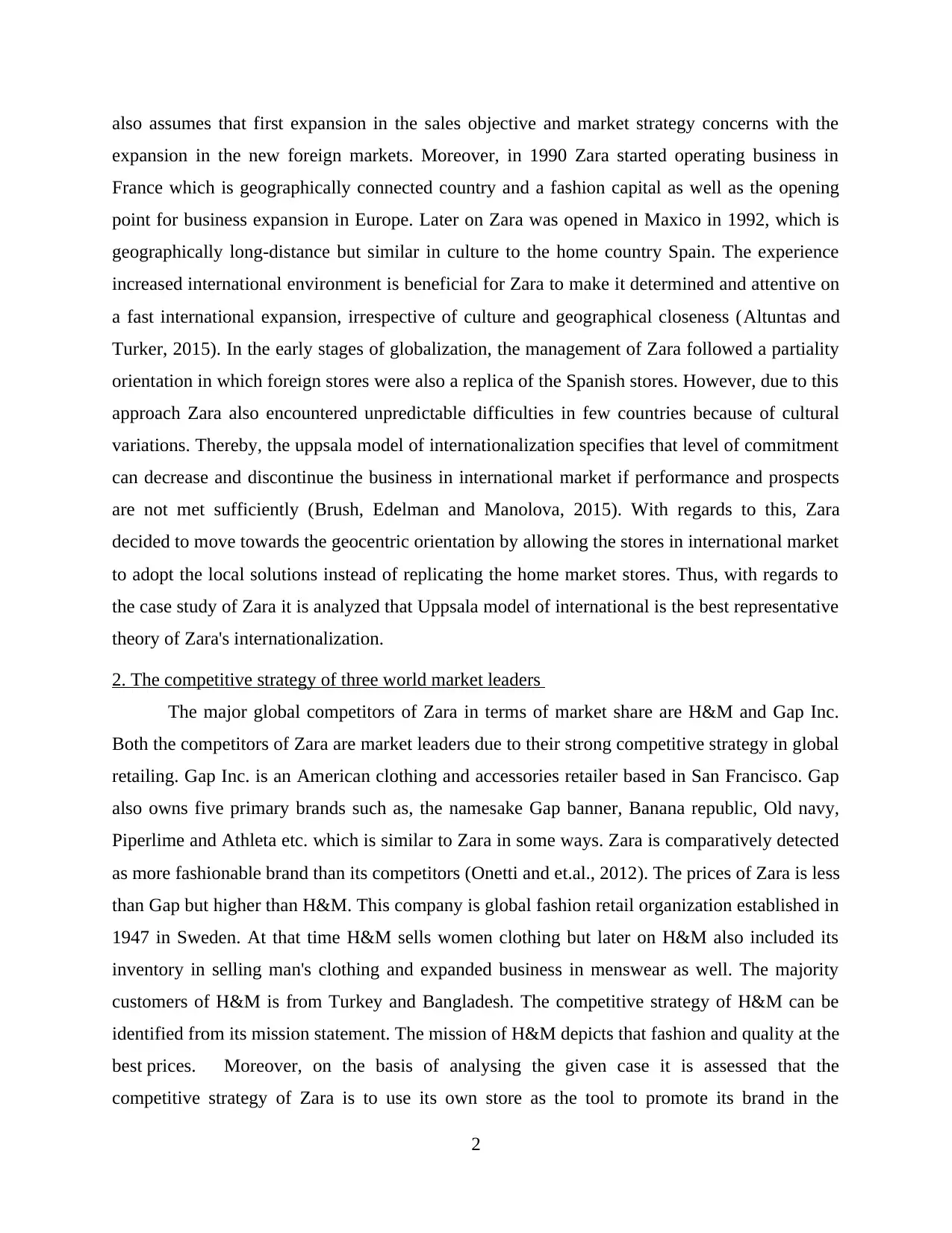
also assumes that first expansion in the sales objective and market strategy concerns with the
expansion in the new foreign markets. Moreover, in 1990 Zara started operating business in
France which is geographically connected country and a fashion capital as well as the opening
point for business expansion in Europe. Later on Zara was opened in Maxico in 1992, which is
geographically long-distance but similar in culture to the home country Spain. The experience
increased international environment is beneficial for Zara to make it determined and attentive on
a fast international expansion, irrespective of culture and geographical closeness (Altuntas and
Turker, 2015). In the early stages of globalization, the management of Zara followed a partiality
orientation in which foreign stores were also a replica of the Spanish stores. However, due to this
approach Zara also encountered unpredictable difficulties in few countries because of cultural
variations. Thereby, the uppsala model of internationalization specifies that level of commitment
can decrease and discontinue the business in international market if performance and prospects
are not met sufficiently (Brush, Edelman and Manolova, 2015). With regards to this, Zara
decided to move towards the geocentric orientation by allowing the stores in international market
to adopt the local solutions instead of replicating the home market stores. Thus, with regards to
the case study of Zara it is analyzed that Uppsala model of international is the best representative
theory of Zara's internationalization.
2. The competitive strategy of three world market leaders
The major global competitors of Zara in terms of market share are H&M and Gap Inc.
Both the competitors of Zara are market leaders due to their strong competitive strategy in global
retailing. Gap Inc. is an American clothing and accessories retailer based in San Francisco. Gap
also owns five primary brands such as, the namesake Gap banner, Banana republic, Old navy,
Piperlime and Athleta etc. which is similar to Zara in some ways. Zara is comparatively detected
as more fashionable brand than its competitors (Onetti and et.al., 2012). The prices of Zara is less
than Gap but higher than H&M. This company is global fashion retail organization established in
1947 in Sweden. At that time H&M sells women clothing but later on H&M also included its
inventory in selling man's clothing and expanded business in menswear as well. The majority
customers of H&M is from Turkey and Bangladesh. The competitive strategy of H&M can be
identified from its mission statement. The mission of H&M depicts that fashion and quality at the
best prices. Moreover, on the basis of analysing the given case it is assessed that the
competitive strategy of Zara is to use its own store as the tool to promote its brand in the
2
expansion in the new foreign markets. Moreover, in 1990 Zara started operating business in
France which is geographically connected country and a fashion capital as well as the opening
point for business expansion in Europe. Later on Zara was opened in Maxico in 1992, which is
geographically long-distance but similar in culture to the home country Spain. The experience
increased international environment is beneficial for Zara to make it determined and attentive on
a fast international expansion, irrespective of culture and geographical closeness (Altuntas and
Turker, 2015). In the early stages of globalization, the management of Zara followed a partiality
orientation in which foreign stores were also a replica of the Spanish stores. However, due to this
approach Zara also encountered unpredictable difficulties in few countries because of cultural
variations. Thereby, the uppsala model of internationalization specifies that level of commitment
can decrease and discontinue the business in international market if performance and prospects
are not met sufficiently (Brush, Edelman and Manolova, 2015). With regards to this, Zara
decided to move towards the geocentric orientation by allowing the stores in international market
to adopt the local solutions instead of replicating the home market stores. Thus, with regards to
the case study of Zara it is analyzed that Uppsala model of international is the best representative
theory of Zara's internationalization.
2. The competitive strategy of three world market leaders
The major global competitors of Zara in terms of market share are H&M and Gap Inc.
Both the competitors of Zara are market leaders due to their strong competitive strategy in global
retailing. Gap Inc. is an American clothing and accessories retailer based in San Francisco. Gap
also owns five primary brands such as, the namesake Gap banner, Banana republic, Old navy,
Piperlime and Athleta etc. which is similar to Zara in some ways. Zara is comparatively detected
as more fashionable brand than its competitors (Onetti and et.al., 2012). The prices of Zara is less
than Gap but higher than H&M. This company is global fashion retail organization established in
1947 in Sweden. At that time H&M sells women clothing but later on H&M also included its
inventory in selling man's clothing and expanded business in menswear as well. The majority
customers of H&M is from Turkey and Bangladesh. The competitive strategy of H&M can be
identified from its mission statement. The mission of H&M depicts that fashion and quality at the
best prices. Moreover, on the basis of analysing the given case it is assessed that the
competitive strategy of Zara is to use its own store as the tool to promote its brand in the
2
Paraphrase This Document
Need a fresh take? Get an instant paraphrase of this document with our AI Paraphraser
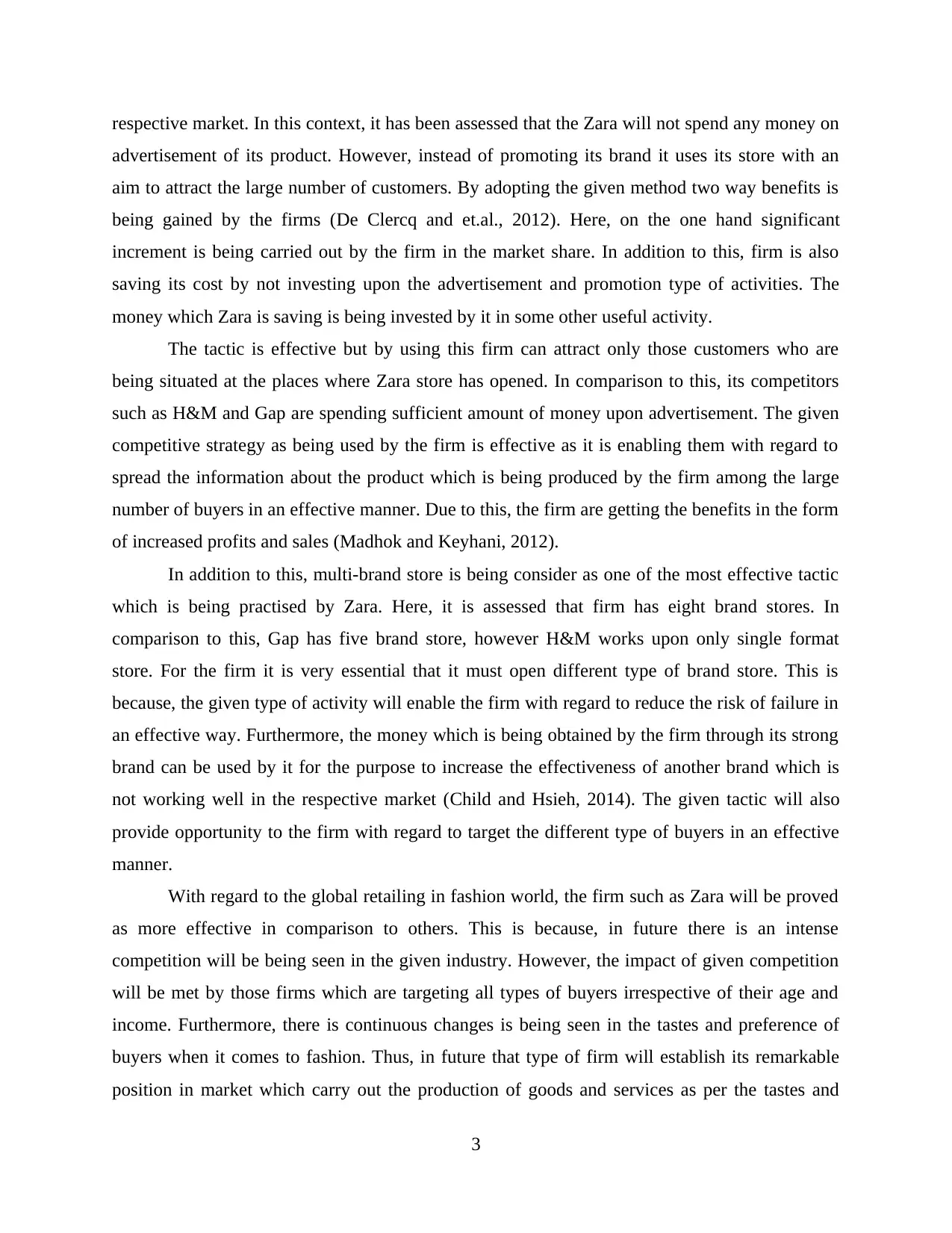
respective market. In this context, it has been assessed that the Zara will not spend any money on
advertisement of its product. However, instead of promoting its brand it uses its store with an
aim to attract the large number of customers. By adopting the given method two way benefits is
being gained by the firms (De Clercq and et.al., 2012). Here, on the one hand significant
increment is being carried out by the firm in the market share. In addition to this, firm is also
saving its cost by not investing upon the advertisement and promotion type of activities. The
money which Zara is saving is being invested by it in some other useful activity.
The tactic is effective but by using this firm can attract only those customers who are
being situated at the places where Zara store has opened. In comparison to this, its competitors
such as H&M and Gap are spending sufficient amount of money upon advertisement. The given
competitive strategy as being used by the firm is effective as it is enabling them with regard to
spread the information about the product which is being produced by the firm among the large
number of buyers in an effective manner. Due to this, the firm are getting the benefits in the form
of increased profits and sales (Madhok and Keyhani, 2012).
In addition to this, multi-brand store is being consider as one of the most effective tactic
which is being practised by Zara. Here, it is assessed that firm has eight brand stores. In
comparison to this, Gap has five brand store, however H&M works upon only single format
store. For the firm it is very essential that it must open different type of brand store. This is
because, the given type of activity will enable the firm with regard to reduce the risk of failure in
an effective way. Furthermore, the money which is being obtained by the firm through its strong
brand can be used by it for the purpose to increase the effectiveness of another brand which is
not working well in the respective market (Child and Hsieh, 2014). The given tactic will also
provide opportunity to the firm with regard to target the different type of buyers in an effective
manner.
With regard to the global retailing in fashion world, the firm such as Zara will be proved
as more effective in comparison to others. This is because, in future there is an intense
competition will be being seen in the given industry. However, the impact of given competition
will be met by those firms which are targeting all types of buyers irrespective of their age and
income. Furthermore, there is continuous changes is being seen in the tastes and preference of
buyers when it comes to fashion. Thus, in future that type of firm will establish its remarkable
position in market which carry out the production of goods and services as per the tastes and
3
advertisement of its product. However, instead of promoting its brand it uses its store with an
aim to attract the large number of customers. By adopting the given method two way benefits is
being gained by the firms (De Clercq and et.al., 2012). Here, on the one hand significant
increment is being carried out by the firm in the market share. In addition to this, firm is also
saving its cost by not investing upon the advertisement and promotion type of activities. The
money which Zara is saving is being invested by it in some other useful activity.
The tactic is effective but by using this firm can attract only those customers who are
being situated at the places where Zara store has opened. In comparison to this, its competitors
such as H&M and Gap are spending sufficient amount of money upon advertisement. The given
competitive strategy as being used by the firm is effective as it is enabling them with regard to
spread the information about the product which is being produced by the firm among the large
number of buyers in an effective manner. Due to this, the firm are getting the benefits in the form
of increased profits and sales (Madhok and Keyhani, 2012).
In addition to this, multi-brand store is being consider as one of the most effective tactic
which is being practised by Zara. Here, it is assessed that firm has eight brand stores. In
comparison to this, Gap has five brand store, however H&M works upon only single format
store. For the firm it is very essential that it must open different type of brand store. This is
because, the given type of activity will enable the firm with regard to reduce the risk of failure in
an effective way. Furthermore, the money which is being obtained by the firm through its strong
brand can be used by it for the purpose to increase the effectiveness of another brand which is
not working well in the respective market (Child and Hsieh, 2014). The given tactic will also
provide opportunity to the firm with regard to target the different type of buyers in an effective
manner.
With regard to the global retailing in fashion world, the firm such as Zara will be proved
as more effective in comparison to others. This is because, in future there is an intense
competition will be being seen in the given industry. However, the impact of given competition
will be met by those firms which are targeting all types of buyers irrespective of their age and
income. Furthermore, there is continuous changes is being seen in the tastes and preference of
buyers when it comes to fashion. Thus, in future that type of firm will establish its remarkable
position in market which carry out the production of goods and services as per the tastes and
3
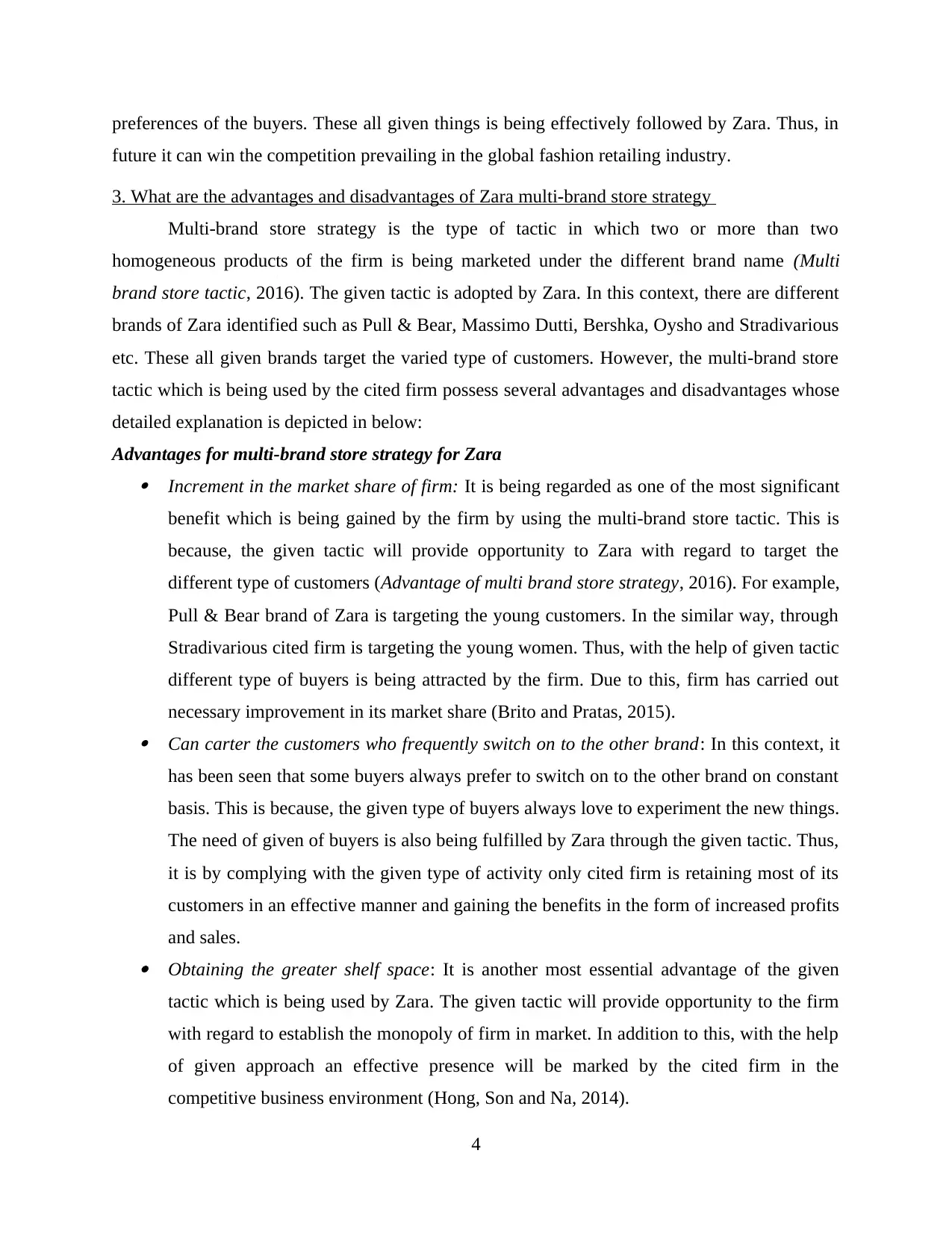
preferences of the buyers. These all given things is being effectively followed by Zara. Thus, in
future it can win the competition prevailing in the global fashion retailing industry.
3. What are the advantages and disadvantages of Zara multi-brand store strategy
Multi-brand store strategy is the type of tactic in which two or more than two
homogeneous products of the firm is being marketed under the different brand name (Multi
brand store tactic, 2016). The given tactic is adopted by Zara. In this context, there are different
brands of Zara identified such as Pull & Bear, Massimo Dutti, Bershka, Oysho and Stradivarious
etc. These all given brands target the varied type of customers. However, the multi-brand store
tactic which is being used by the cited firm possess several advantages and disadvantages whose
detailed explanation is depicted in below:
Advantages for multi-brand store strategy for Zara Increment in the market share of firm: It is being regarded as one of the most significant
benefit which is being gained by the firm by using the multi-brand store tactic. This is
because, the given tactic will provide opportunity to Zara with regard to target the
different type of customers (Advantage of multi brand store strategy, 2016). For example,
Pull & Bear brand of Zara is targeting the young customers. In the similar way, through
Stradivarious cited firm is targeting the young women. Thus, with the help of given tactic
different type of buyers is being attracted by the firm. Due to this, firm has carried out
necessary improvement in its market share (Brito and Pratas, 2015). Can carter the customers who frequently switch on to the other brand: In this context, it
has been seen that some buyers always prefer to switch on to the other brand on constant
basis. This is because, the given type of buyers always love to experiment the new things.
The need of given of buyers is also being fulfilled by Zara through the given tactic. Thus,
it is by complying with the given type of activity only cited firm is retaining most of its
customers in an effective manner and gaining the benefits in the form of increased profits
and sales. Obtaining the greater shelf space: It is another most essential advantage of the given
tactic which is being used by Zara. The given tactic will provide opportunity to the firm
with regard to establish the monopoly of firm in market. In addition to this, with the help
of given approach an effective presence will be marked by the cited firm in the
competitive business environment (Hong, Son and Na, 2014).
4
future it can win the competition prevailing in the global fashion retailing industry.
3. What are the advantages and disadvantages of Zara multi-brand store strategy
Multi-brand store strategy is the type of tactic in which two or more than two
homogeneous products of the firm is being marketed under the different brand name (Multi
brand store tactic, 2016). The given tactic is adopted by Zara. In this context, there are different
brands of Zara identified such as Pull & Bear, Massimo Dutti, Bershka, Oysho and Stradivarious
etc. These all given brands target the varied type of customers. However, the multi-brand store
tactic which is being used by the cited firm possess several advantages and disadvantages whose
detailed explanation is depicted in below:
Advantages for multi-brand store strategy for Zara Increment in the market share of firm: It is being regarded as one of the most significant
benefit which is being gained by the firm by using the multi-brand store tactic. This is
because, the given tactic will provide opportunity to Zara with regard to target the
different type of customers (Advantage of multi brand store strategy, 2016). For example,
Pull & Bear brand of Zara is targeting the young customers. In the similar way, through
Stradivarious cited firm is targeting the young women. Thus, with the help of given tactic
different type of buyers is being attracted by the firm. Due to this, firm has carried out
necessary improvement in its market share (Brito and Pratas, 2015). Can carter the customers who frequently switch on to the other brand: In this context, it
has been seen that some buyers always prefer to switch on to the other brand on constant
basis. This is because, the given type of buyers always love to experiment the new things.
The need of given of buyers is also being fulfilled by Zara through the given tactic. Thus,
it is by complying with the given type of activity only cited firm is retaining most of its
customers in an effective manner and gaining the benefits in the form of increased profits
and sales. Obtaining the greater shelf space: It is another most essential advantage of the given
tactic which is being used by Zara. The given tactic will provide opportunity to the firm
with regard to establish the monopoly of firm in market. In addition to this, with the help
of given approach an effective presence will be marked by the cited firm in the
competitive business environment (Hong, Son and Na, 2014).
4
⊘ This is a preview!⊘
Do you want full access?
Subscribe today to unlock all pages.

Trusted by 1+ million students worldwide
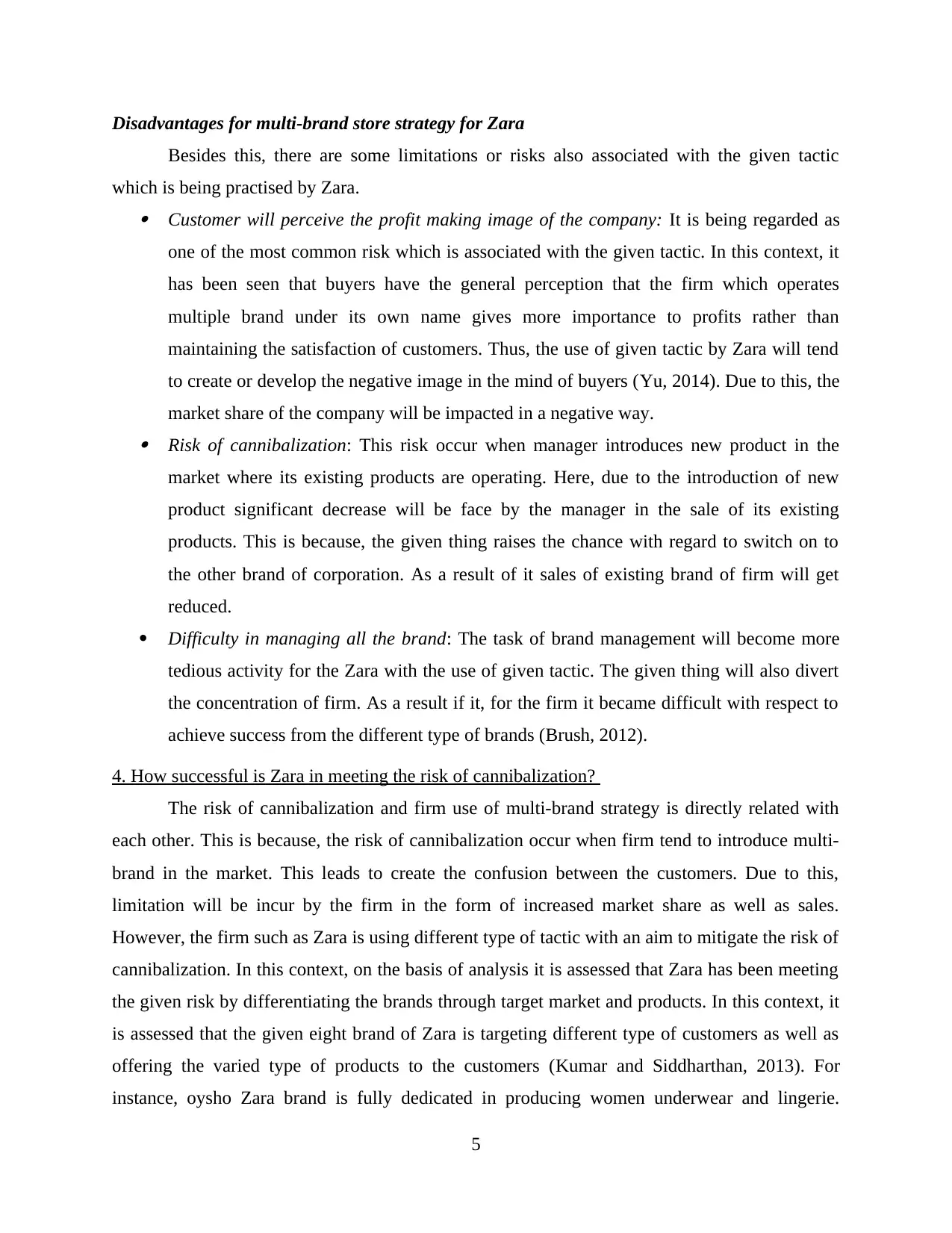
Disadvantages for multi-brand store strategy for Zara
Besides this, there are some limitations or risks also associated with the given tactic
which is being practised by Zara. Customer will perceive the profit making image of the company: It is being regarded as
one of the most common risk which is associated with the given tactic. In this context, it
has been seen that buyers have the general perception that the firm which operates
multiple brand under its own name gives more importance to profits rather than
maintaining the satisfaction of customers. Thus, the use of given tactic by Zara will tend
to create or develop the negative image in the mind of buyers (Yu, 2014). Due to this, the
market share of the company will be impacted in a negative way. Risk of cannibalization: This risk occur when manager introduces new product in the
market where its existing products are operating. Here, due to the introduction of new
product significant decrease will be face by the manager in the sale of its existing
products. This is because, the given thing raises the chance with regard to switch on to
the other brand of corporation. As a result of it sales of existing brand of firm will get
reduced.
Difficulty in managing all the brand: The task of brand management will become more
tedious activity for the Zara with the use of given tactic. The given thing will also divert
the concentration of firm. As a result if it, for the firm it became difficult with respect to
achieve success from the different type of brands (Brush, 2012).
4. How successful is Zara in meeting the risk of cannibalization?
The risk of cannibalization and firm use of multi-brand strategy is directly related with
each other. This is because, the risk of cannibalization occur when firm tend to introduce multi-
brand in the market. This leads to create the confusion between the customers. Due to this,
limitation will be incur by the firm in the form of increased market share as well as sales.
However, the firm such as Zara is using different type of tactic with an aim to mitigate the risk of
cannibalization. In this context, on the basis of analysis it is assessed that Zara has been meeting
the given risk by differentiating the brands through target market and products. In this context, it
is assessed that the given eight brand of Zara is targeting different type of customers as well as
offering the varied type of products to the customers (Kumar and Siddharthan, 2013). For
instance, oysho Zara brand is fully dedicated in producing women underwear and lingerie.
5
Besides this, there are some limitations or risks also associated with the given tactic
which is being practised by Zara. Customer will perceive the profit making image of the company: It is being regarded as
one of the most common risk which is associated with the given tactic. In this context, it
has been seen that buyers have the general perception that the firm which operates
multiple brand under its own name gives more importance to profits rather than
maintaining the satisfaction of customers. Thus, the use of given tactic by Zara will tend
to create or develop the negative image in the mind of buyers (Yu, 2014). Due to this, the
market share of the company will be impacted in a negative way. Risk of cannibalization: This risk occur when manager introduces new product in the
market where its existing products are operating. Here, due to the introduction of new
product significant decrease will be face by the manager in the sale of its existing
products. This is because, the given thing raises the chance with regard to switch on to
the other brand of corporation. As a result of it sales of existing brand of firm will get
reduced.
Difficulty in managing all the brand: The task of brand management will become more
tedious activity for the Zara with the use of given tactic. The given thing will also divert
the concentration of firm. As a result if it, for the firm it became difficult with respect to
achieve success from the different type of brands (Brush, 2012).
4. How successful is Zara in meeting the risk of cannibalization?
The risk of cannibalization and firm use of multi-brand strategy is directly related with
each other. This is because, the risk of cannibalization occur when firm tend to introduce multi-
brand in the market. This leads to create the confusion between the customers. Due to this,
limitation will be incur by the firm in the form of increased market share as well as sales.
However, the firm such as Zara is using different type of tactic with an aim to mitigate the risk of
cannibalization. In this context, on the basis of analysis it is assessed that Zara has been meeting
the given risk by differentiating the brands through target market and products. In this context, it
is assessed that the given eight brand of Zara is targeting different type of customers as well as
offering the varied type of products to the customers (Kumar and Siddharthan, 2013). For
instance, oysho Zara brand is fully dedicated in producing women underwear and lingerie.
5
Paraphrase This Document
Need a fresh take? Get an instant paraphrase of this document with our AI Paraphraser
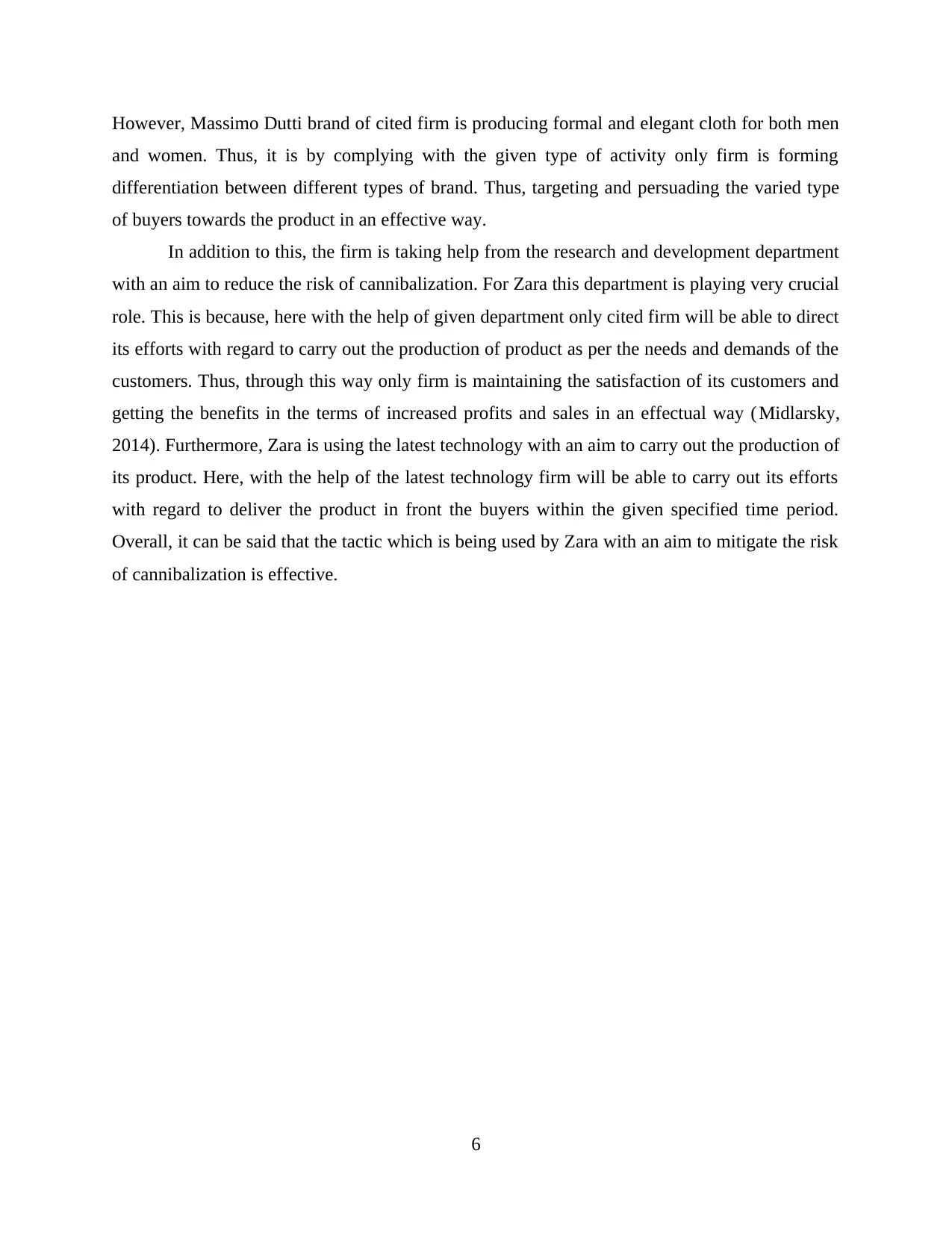
However, Massimo Dutti brand of cited firm is producing formal and elegant cloth for both men
and women. Thus, it is by complying with the given type of activity only firm is forming
differentiation between different types of brand. Thus, targeting and persuading the varied type
of buyers towards the product in an effective way.
In addition to this, the firm is taking help from the research and development department
with an aim to reduce the risk of cannibalization. For Zara this department is playing very crucial
role. This is because, here with the help of given department only cited firm will be able to direct
its efforts with regard to carry out the production of product as per the needs and demands of the
customers. Thus, through this way only firm is maintaining the satisfaction of its customers and
getting the benefits in the terms of increased profits and sales in an effectual way ( Midlarsky,
2014). Furthermore, Zara is using the latest technology with an aim to carry out the production of
its product. Here, with the help of the latest technology firm will be able to carry out its efforts
with regard to deliver the product in front the buyers within the given specified time period.
Overall, it can be said that the tactic which is being used by Zara with an aim to mitigate the risk
of cannibalization is effective.
6
and women. Thus, it is by complying with the given type of activity only firm is forming
differentiation between different types of brand. Thus, targeting and persuading the varied type
of buyers towards the product in an effective way.
In addition to this, the firm is taking help from the research and development department
with an aim to reduce the risk of cannibalization. For Zara this department is playing very crucial
role. This is because, here with the help of given department only cited firm will be able to direct
its efforts with regard to carry out the production of product as per the needs and demands of the
customers. Thus, through this way only firm is maintaining the satisfaction of its customers and
getting the benefits in the terms of increased profits and sales in an effectual way ( Midlarsky,
2014). Furthermore, Zara is using the latest technology with an aim to carry out the production of
its product. Here, with the help of the latest technology firm will be able to carry out its efforts
with regard to deliver the product in front the buyers within the given specified time period.
Overall, it can be said that the tactic which is being used by Zara with an aim to mitigate the risk
of cannibalization is effective.
6
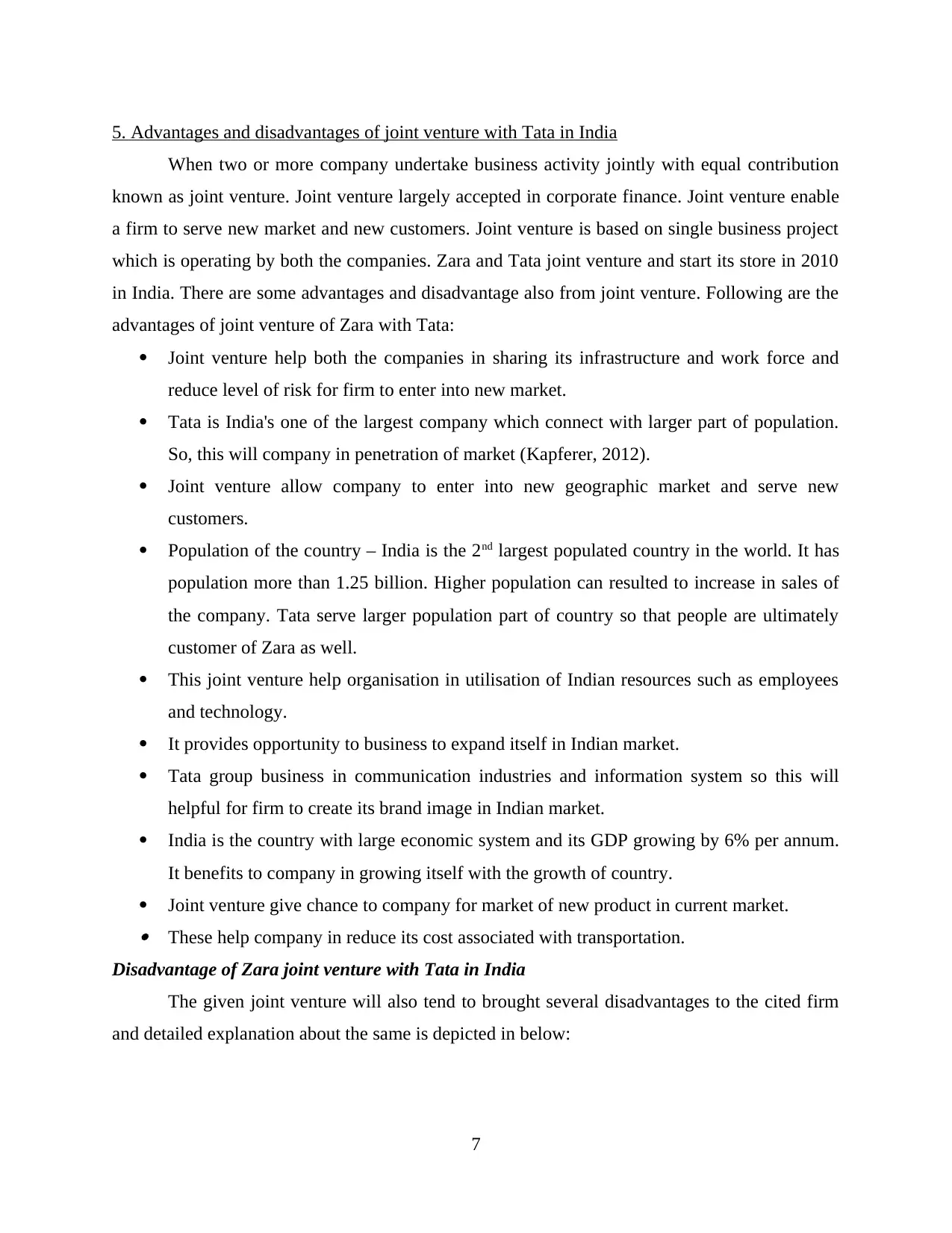
5. Advantages and disadvantages of joint venture with Tata in India
When two or more company undertake business activity jointly with equal contribution
known as joint venture. Joint venture largely accepted in corporate finance. Joint venture enable
a firm to serve new market and new customers. Joint venture is based on single business project
which is operating by both the companies. Zara and Tata joint venture and start its store in 2010
in India. There are some advantages and disadvantage also from joint venture. Following are the
advantages of joint venture of Zara with Tata:
Joint venture help both the companies in sharing its infrastructure and work force and
reduce level of risk for firm to enter into new market.
Tata is India's one of the largest company which connect with larger part of population.
So, this will company in penetration of market (Kapferer, 2012).
Joint venture allow company to enter into new geographic market and serve new
customers.
Population of the country – India is the 2nd largest populated country in the world. It has
population more than 1.25 billion. Higher population can resulted to increase in sales of
the company. Tata serve larger population part of country so that people are ultimately
customer of Zara as well.
This joint venture help organisation in utilisation of Indian resources such as employees
and technology.
It provides opportunity to business to expand itself in Indian market.
Tata group business in communication industries and information system so this will
helpful for firm to create its brand image in Indian market.
India is the country with large economic system and its GDP growing by 6% per annum.
It benefits to company in growing itself with the growth of country.
Joint venture give chance to company for market of new product in current market. These help company in reduce its cost associated with transportation.
Disadvantage of Zara joint venture with Tata in India
The given joint venture will also tend to brought several disadvantages to the cited firm
and detailed explanation about the same is depicted in below:
7
When two or more company undertake business activity jointly with equal contribution
known as joint venture. Joint venture largely accepted in corporate finance. Joint venture enable
a firm to serve new market and new customers. Joint venture is based on single business project
which is operating by both the companies. Zara and Tata joint venture and start its store in 2010
in India. There are some advantages and disadvantage also from joint venture. Following are the
advantages of joint venture of Zara with Tata:
Joint venture help both the companies in sharing its infrastructure and work force and
reduce level of risk for firm to enter into new market.
Tata is India's one of the largest company which connect with larger part of population.
So, this will company in penetration of market (Kapferer, 2012).
Joint venture allow company to enter into new geographic market and serve new
customers.
Population of the country – India is the 2nd largest populated country in the world. It has
population more than 1.25 billion. Higher population can resulted to increase in sales of
the company. Tata serve larger population part of country so that people are ultimately
customer of Zara as well.
This joint venture help organisation in utilisation of Indian resources such as employees
and technology.
It provides opportunity to business to expand itself in Indian market.
Tata group business in communication industries and information system so this will
helpful for firm to create its brand image in Indian market.
India is the country with large economic system and its GDP growing by 6% per annum.
It benefits to company in growing itself with the growth of country.
Joint venture give chance to company for market of new product in current market. These help company in reduce its cost associated with transportation.
Disadvantage of Zara joint venture with Tata in India
The given joint venture will also tend to brought several disadvantages to the cited firm
and detailed explanation about the same is depicted in below:
7
⊘ This is a preview!⊘
Do you want full access?
Subscribe today to unlock all pages.

Trusted by 1+ million students worldwide
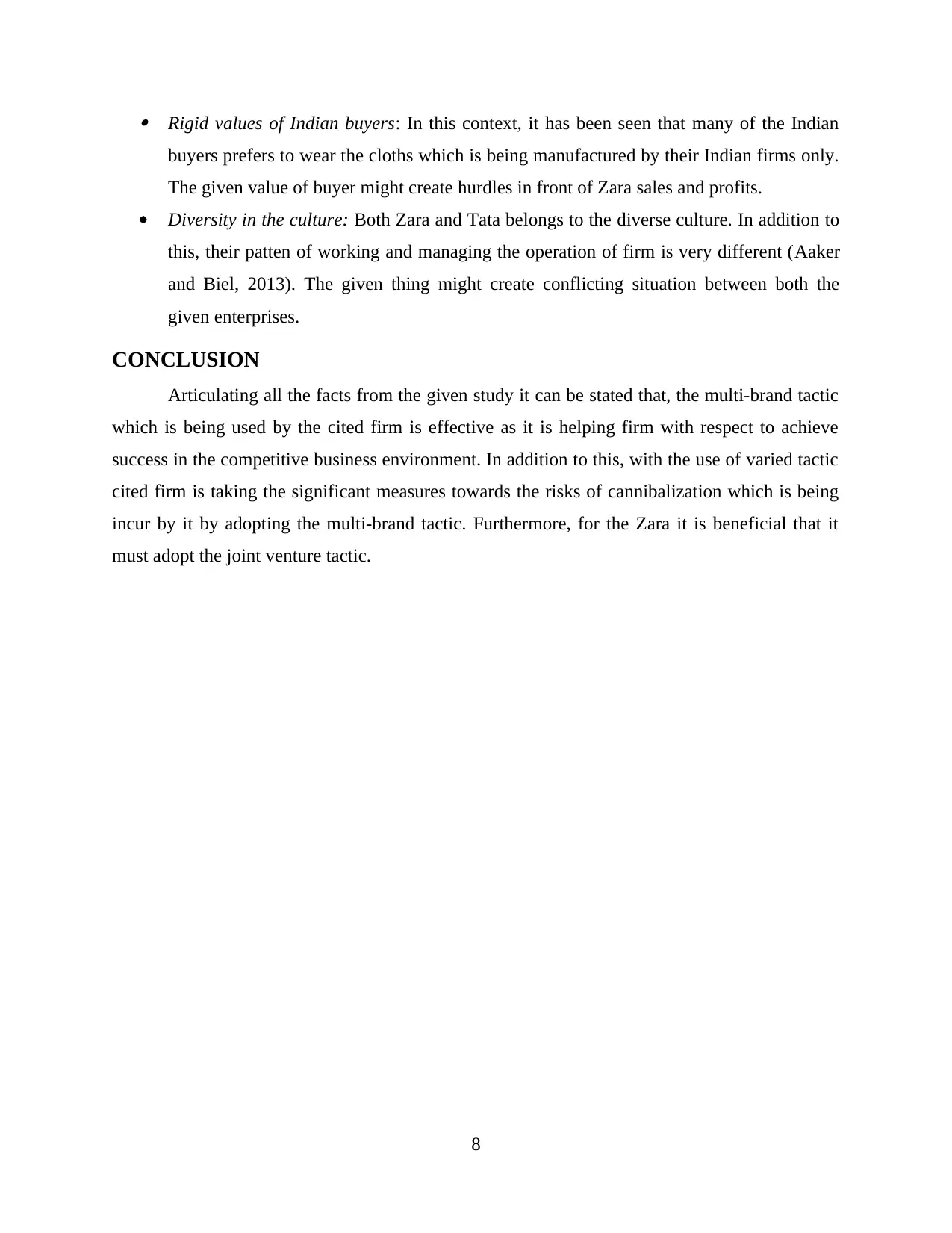
Rigid values of Indian buyers: In this context, it has been seen that many of the Indian
buyers prefers to wear the cloths which is being manufactured by their Indian firms only.
The given value of buyer might create hurdles in front of Zara sales and profits.
Diversity in the culture: Both Zara and Tata belongs to the diverse culture. In addition to
this, their patten of working and managing the operation of firm is very different (Aaker
and Biel, 2013). The given thing might create conflicting situation between both the
given enterprises.
CONCLUSION
Articulating all the facts from the given study it can be stated that, the multi-brand tactic
which is being used by the cited firm is effective as it is helping firm with respect to achieve
success in the competitive business environment. In addition to this, with the use of varied tactic
cited firm is taking the significant measures towards the risks of cannibalization which is being
incur by it by adopting the multi-brand tactic. Furthermore, for the Zara it is beneficial that it
must adopt the joint venture tactic.
8
buyers prefers to wear the cloths which is being manufactured by their Indian firms only.
The given value of buyer might create hurdles in front of Zara sales and profits.
Diversity in the culture: Both Zara and Tata belongs to the diverse culture. In addition to
this, their patten of working and managing the operation of firm is very different (Aaker
and Biel, 2013). The given thing might create conflicting situation between both the
given enterprises.
CONCLUSION
Articulating all the facts from the given study it can be stated that, the multi-brand tactic
which is being used by the cited firm is effective as it is helping firm with respect to achieve
success in the competitive business environment. In addition to this, with the use of varied tactic
cited firm is taking the significant measures towards the risks of cannibalization which is being
incur by it by adopting the multi-brand tactic. Furthermore, for the Zara it is beneficial that it
must adopt the joint venture tactic.
8
Paraphrase This Document
Need a fresh take? Get an instant paraphrase of this document with our AI Paraphraser
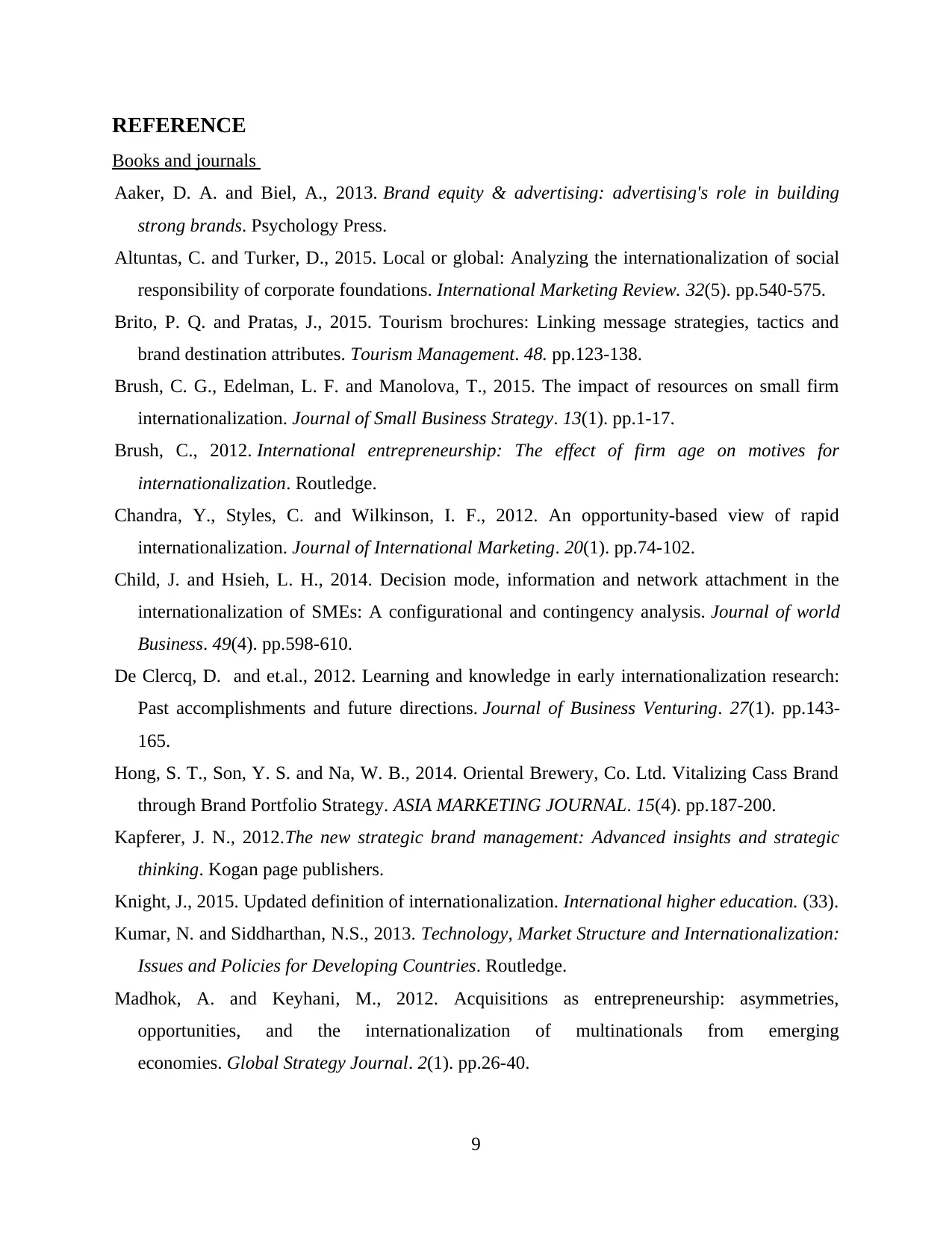
REFERENCE
Books and journals
Aaker, D. A. and Biel, A., 2013. Brand equity & advertising: advertising's role in building
strong brands. Psychology Press.
Altuntas, C. and Turker, D., 2015. Local or global: Analyzing the internationalization of social
responsibility of corporate foundations. International Marketing Review. 32(5). pp.540-575.
Brito, P. Q. and Pratas, J., 2015. Tourism brochures: Linking message strategies, tactics and
brand destination attributes. Tourism Management. 48. pp.123-138.
Brush, C. G., Edelman, L. F. and Manolova, T., 2015. The impact of resources on small firm
internationalization. Journal of Small Business Strategy. 13(1). pp.1-17.
Brush, C., 2012. International entrepreneurship: The effect of firm age on motives for
internationalization. Routledge.
Chandra, Y., Styles, C. and Wilkinson, I. F., 2012. An opportunity-based view of rapid
internationalization. Journal of International Marketing. 20(1). pp.74-102.
Child, J. and Hsieh, L. H., 2014. Decision mode, information and network attachment in the
internationalization of SMEs: A configurational and contingency analysis. Journal of world
Business. 49(4). pp.598-610.
De Clercq, D. and et.al., 2012. Learning and knowledge in early internationalization research:
Past accomplishments and future directions. Journal of Business Venturing. 27(1). pp.143-
165.
Hong, S. T., Son, Y. S. and Na, W. B., 2014. Oriental Brewery, Co. Ltd. Vitalizing Cass Brand
through Brand Portfolio Strategy. ASIA MARKETING JOURNAL. 15(4). pp.187-200.
Kapferer, J. N., 2012.The new strategic brand management: Advanced insights and strategic
thinking. Kogan page publishers.
Knight, J., 2015. Updated definition of internationalization. International higher education. (33).
Kumar, N. and Siddharthan, N.S., 2013. Technology, Market Structure and Internationalization:
Issues and Policies for Developing Countries. Routledge.
Madhok, A. and Keyhani, M., 2012. Acquisitions as entrepreneurship: asymmetries,
opportunities, and the internationalization of multinationals from emerging
economies. Global Strategy Journal. 2(1). pp.26-40.
9
Books and journals
Aaker, D. A. and Biel, A., 2013. Brand equity & advertising: advertising's role in building
strong brands. Psychology Press.
Altuntas, C. and Turker, D., 2015. Local or global: Analyzing the internationalization of social
responsibility of corporate foundations. International Marketing Review. 32(5). pp.540-575.
Brito, P. Q. and Pratas, J., 2015. Tourism brochures: Linking message strategies, tactics and
brand destination attributes. Tourism Management. 48. pp.123-138.
Brush, C. G., Edelman, L. F. and Manolova, T., 2015. The impact of resources on small firm
internationalization. Journal of Small Business Strategy. 13(1). pp.1-17.
Brush, C., 2012. International entrepreneurship: The effect of firm age on motives for
internationalization. Routledge.
Chandra, Y., Styles, C. and Wilkinson, I. F., 2012. An opportunity-based view of rapid
internationalization. Journal of International Marketing. 20(1). pp.74-102.
Child, J. and Hsieh, L. H., 2014. Decision mode, information and network attachment in the
internationalization of SMEs: A configurational and contingency analysis. Journal of world
Business. 49(4). pp.598-610.
De Clercq, D. and et.al., 2012. Learning and knowledge in early internationalization research:
Past accomplishments and future directions. Journal of Business Venturing. 27(1). pp.143-
165.
Hong, S. T., Son, Y. S. and Na, W. B., 2014. Oriental Brewery, Co. Ltd. Vitalizing Cass Brand
through Brand Portfolio Strategy. ASIA MARKETING JOURNAL. 15(4). pp.187-200.
Kapferer, J. N., 2012.The new strategic brand management: Advanced insights and strategic
thinking. Kogan page publishers.
Knight, J., 2015. Updated definition of internationalization. International higher education. (33).
Kumar, N. and Siddharthan, N.S., 2013. Technology, Market Structure and Internationalization:
Issues and Policies for Developing Countries. Routledge.
Madhok, A. and Keyhani, M., 2012. Acquisitions as entrepreneurship: asymmetries,
opportunities, and the internationalization of multinationals from emerging
economies. Global Strategy Journal. 2(1). pp.26-40.
9

Midlarsky, M. I., 2014. The Internationalization of Communal Strife (Routledge Revivals).
Routledge.
Onetti, A. and et.al., 2012. Internationalization, innovation and entrepreneurship: business
models for new technology-based firms. Journal of Management & Governance. 16(3).
pp.337-368.
Yu, Y., 2014. Revisiting the Internationalization of the Yuan. Springer Japan.
Online
Advantage of multi brand store strategy. 2016. [Pdf]. Available through: <http://hh.diva-
portal.org/smash/get/diva2:238026/FULLTEXT01.pdf>. [Accessed on 5th January 2016].
Multi brand store tactic. 2016. [Online]. Available through:
<http://www.mbaskool.com/business-concepts/marketing-and-strategy-terms/6821-multi-
branding.html>. [Accessed on 5th January 2016].
Zara. 2016. [Online]. Available through: <http://www.zara.com/in/>. [Accessed on 5th January
2016].
10
Routledge.
Onetti, A. and et.al., 2012. Internationalization, innovation and entrepreneurship: business
models for new technology-based firms. Journal of Management & Governance. 16(3).
pp.337-368.
Yu, Y., 2014. Revisiting the Internationalization of the Yuan. Springer Japan.
Online
Advantage of multi brand store strategy. 2016. [Pdf]. Available through: <http://hh.diva-
portal.org/smash/get/diva2:238026/FULLTEXT01.pdf>. [Accessed on 5th January 2016].
Multi brand store tactic. 2016. [Online]. Available through:
<http://www.mbaskool.com/business-concepts/marketing-and-strategy-terms/6821-multi-
branding.html>. [Accessed on 5th January 2016].
Zara. 2016. [Online]. Available through: <http://www.zara.com/in/>. [Accessed on 5th January
2016].
10
⊘ This is a preview!⊘
Do you want full access?
Subscribe today to unlock all pages.

Trusted by 1+ million students worldwide
1 out of 12
Related Documents
Your All-in-One AI-Powered Toolkit for Academic Success.
+13062052269
info@desklib.com
Available 24*7 on WhatsApp / Email
![[object Object]](/_next/static/media/star-bottom.7253800d.svg)
Unlock your academic potential
Copyright © 2020–2025 A2Z Services. All Rights Reserved. Developed and managed by ZUCOL.





